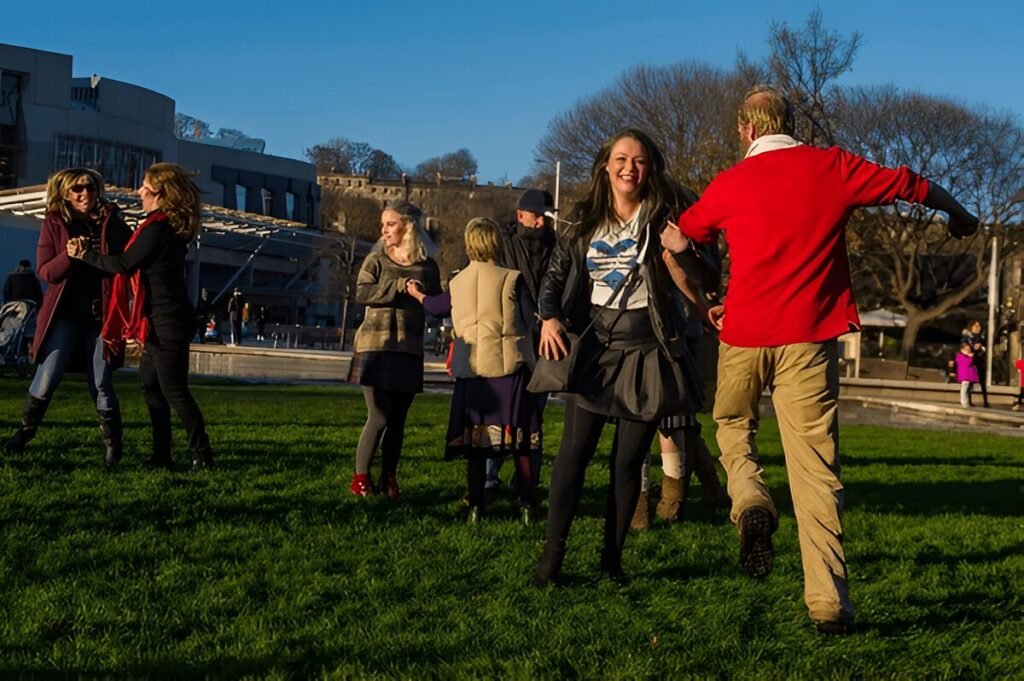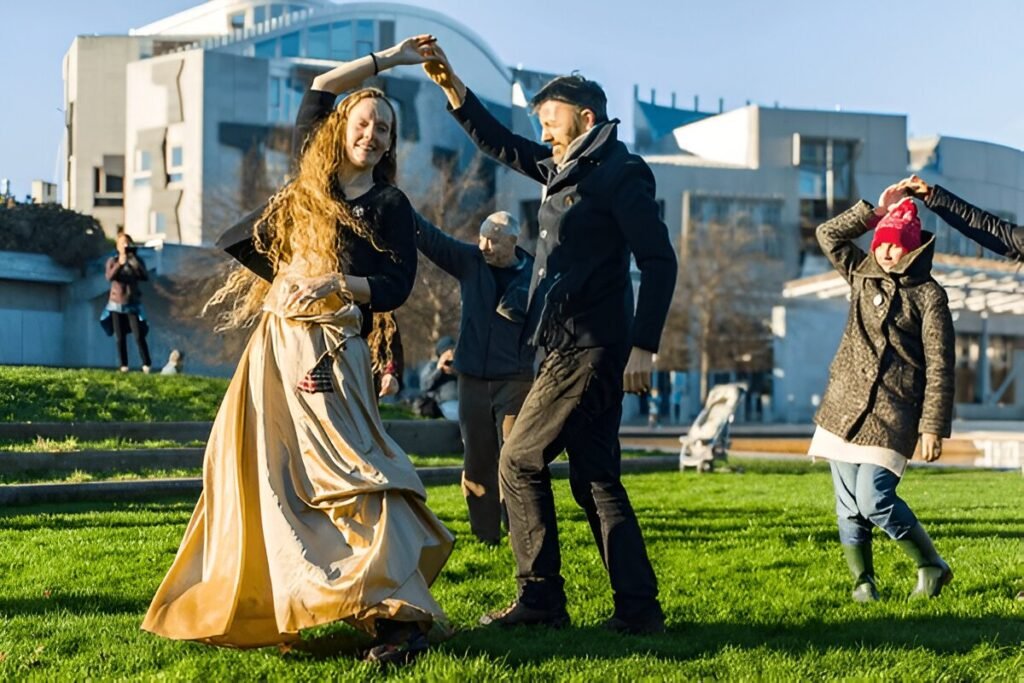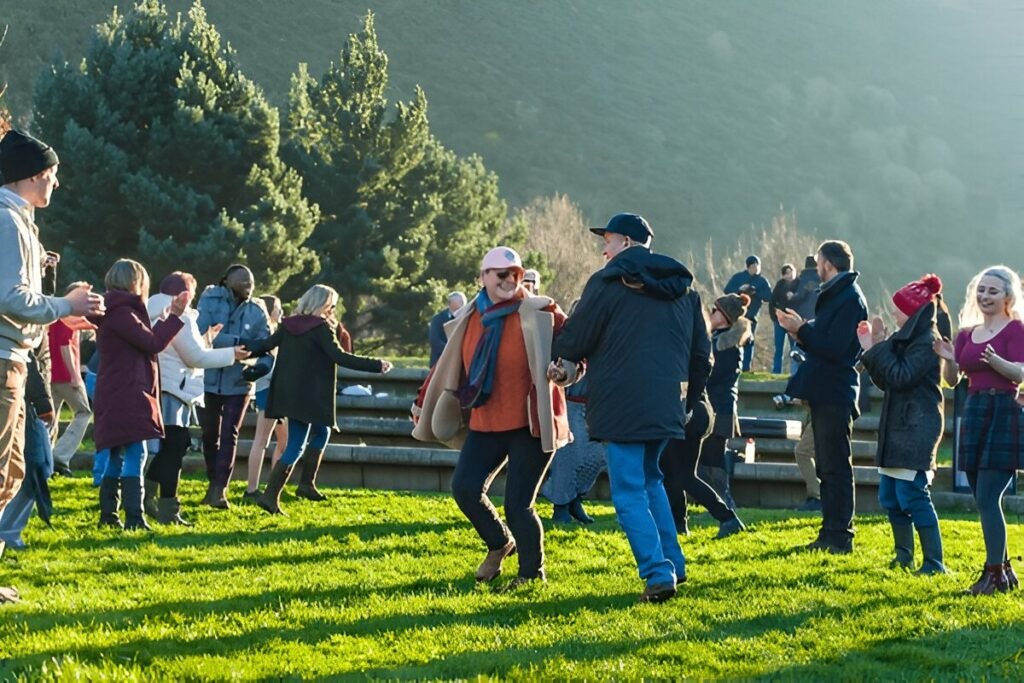Introduction
A ceilidh (pronounced kay-lee) is a traditional Scottish social gathering filled with lively music, dancing, and fun. Whether you’re at a wedding, festival, or local ceilidh night, these events bring people together through energetic group dances that have been part of Scotland’s culture for centuries.
Ceilidh dancing is easy to learn, making it perfect for beginners, and it’s an incredible way to experience Scottish music and hospitality. In this guide, we’ll explore the history of ceilidhs, introduce you to the most popular dances, and provide tips on how to join in—whether you’re a visitor or a seasoned dancer.
The History of Ceilidh Dancing
Origins and Evolution
The word “ceilidh” comes from Gaelic and originally referred to any social gathering, not just dancing. Traditionally, ceilidhs included storytelling, poetry, and music, but over time, dancing became the central focus.
- Ceilidh dancing has roots in Scottish and Irish folk traditions.
- Some ceilidh dances date back hundreds of years, evolving from old European country dances.
- The Victorian era formalized many of the ceilidh steps we recognize today.
Modern Ceilidhs
Today, ceilidhs are a staple of Scottish celebrations, including:
- Weddings – Almost every Scottish wedding features a ceilidh!
- Festivals – Events like Edinburgh’s Hogmanay often have outdoor ceilidhs.
- Community Gatherings – Many towns and villages host ceilidhs regularly.
Ceilidhs have also gained international popularity, with ceilidh nights held in places like London, New York, and even Australia!
Popular Ceilidh Dances and How to Do Them

One of the best things about ceilidh dancing is that you don’t need any experience—there’s usually a “caller” who explains the steps before each dance.
1. The Gay Gordons
This is often the first dance of a ceilidh and is perfect for beginners.
- Formation: Couples stand side by side in a circle around the room.
- Steps:
- Hold your partner’s right hand in your right and left in your left.
- Step forward for four counts, then back for four counts.
- Twirl around together and repeat!
It’s a simple but fun dance that sets the tone for the night.
2. Strip the Willow
One of the most exciting ceilidh dances, Strip the Willow is full of fast spins and high energy!
- Formation: Two long lines of partners facing each other.
- Steps:
- The first couple spins down the set, alternating between left and right arms.
- Once at the bottom, the next couple begins.
- The dance continues until everyone has had a turn.
Expect lots of laughter and a bit of dizziness!
3. The Dashing White Sergeant
This group dance is ideal for making new friends.
- Formation: Sets of three people (often two partners and a third person).
- Steps:
- Circle around and back.
- Swing partners and move forward to form a new group.
- The dance repeats with new sets.
This dance is a ceilidh staple at weddings and large events.
4. The Canadian Barn Dance
Despite its name, this is a classic Scottish ceilidh dance.
- Formation: Couples in a circle.
- Steps:
- Step forward and back twice.
- Turn your partner and move onto the next person.
It’s easy to learn and perfect for beginners.
5. The Eightsome Reel
This is one of the most traditional and lively ceilidh dances.
- Formation: Groups of eight people in a circle.
- Steps:
- The lead couple dances in the center while the others move around.
- The next couple takes their turn in the center.
- The dance repeats until everyone has had a turn.
Reels like this are full of energy and teamwork, making them ceilidh favorites!
Ceilidh Music: The Heartbeat of the Dance

What Instruments Are Used?
A ceilidh band typically features:
- Fiddle – Provides the fast, melodic rhythm.
- Accordion – A key instrument that drives the music.
- Bagpipes – Sometimes used in grand ceilidh performances.
- Piano & Drums – Add rhythm and energy.
Famous Ceilidh Bands
- The Peatbog Faeries – A mix of traditional and modern ceilidh sounds.
- Shooglenifty – A band that blends ceilidh music with folk-rock.
- The Ceilidh Experience – Known for their high-energy performances.
Ceilidh music is fast-paced and infectious, making it nearly impossible to resist dancing!
Where to Experience a Ceilidh in Scotland
If you want to join a ceilidh, here are some of the best places to experience one:
1. Edinburgh
- The Ghillie Dhu – A popular venue with regular ceilidh nights.
- Summerhall – Hosts ceilidhs as part of Edinburgh’s festivals.
2. Glasgow
- Sloans Bar – One of Scotland’s longest-running ceilidhs every Friday night.
- Òran Mór – A stunning venue that combines ceilidh with live music.
3. Inverness & The Highlands
- Hootananny – A must-visit ceilidh bar in Inverness.
- Village Halls – Many Highland villages host ceilidhs throughout the year.
4. Festivals
- Edinburgh Hogmanay – The world’s biggest New Year’s Eve street party, with a massive outdoor ceilidh.
- Celtic Connections (Glasgow) – A celebration of Scottish music and dance.
If you visit Scotland, attending a ceilidh is a must!
Tips for First-Time Ceilidh Dancers

If you’re new to ceilidh dancing, don’t worry! Here are some helpful tips:
- Wear comfortable shoes – You’ll be moving a lot, so avoid heels!
- Listen to the caller – They’ll explain the steps before each dance.
- Don’t be shy – Everyone is there to have fun, and mistakes are part of the experience.
- Stay hydrated – Ceilidh dancing can be energetic, so take water breaks.
- Smile and enjoy – It’s all about laughter and community spirit.
Conclusion
Ceilidh dancing is a joyful, high-energy tradition that brings people together in the best way possible. Whether you’re spinning through a Strip the Willow or stepping into the Gay Gordons, ceilidhs are a celebration of Scotland’s culture, music, and hospitality.
So next time you’re in Scotland, grab a partner, hit the dance floor, and experience the magic of a ceilidh—you won’t regret it!












